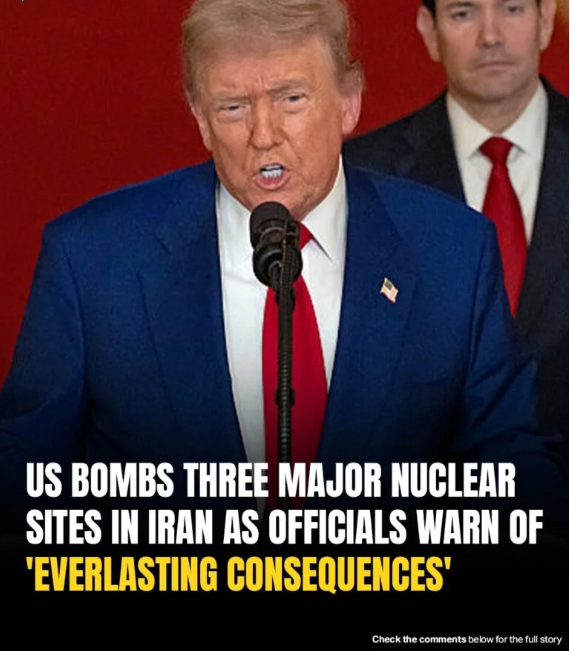The United States launched a dramatic military operation on June 22, 2025, targeting three key Iranian nuclear facilities—Fordow, Natanz, and Isfahan—escalating tensions in the Middle East and drawing sharp condemnation from Iran. President Donald Trump hailed the strikes as a “spectacular military success,” claiming they “totally obliterated” Iran’s nuclear enrichment capacity. However, conflicting reports, including from the International Atomic Energy Agency (IAEA), suggest the damage may be less severe, raising questions about the strikes’ effectiveness and long-term consequences. As Iran vows retaliation, the world braces for a potential spiral into wider conflict.
The Strikes: A High-Stakes Operation
At 7:50 p.m. ET on June 21 (3:20 a.m. Iran time, June 22), Trump announced via Truth Social that U.S. forces had struck Fordow, Natanz, and Isfahan, key pillars of Iran’s nuclear program. In a televised White House address, flanked by Vice President JD Vance, Secretary of State Marco Rubio, and Defense Secretary Pete Hegseth, he declared the strikes aimed to “destroy Iran’s nuclear enrichment capacity” and curb the “world’s number one state sponsor of terror.”
The operation, dubbed Operation Midnight Hammer, involved:
-
Seven B-2 stealth bombers, each carrying 30,000-pound GBU-57 Massive Ordnance Penetrators (MOPs, or “bunker busters”). Fourteen MOPs were dropped on Fordow, with two also targeting Natanz.
-
Over 30 Tomahawk cruise missiles launched from U.S. Navy submarines, striking Isfahan and Natanz.
-
Deception tactics, including decoy B-2s flying west over the Pacific and fighter jets clearing Iranian airspace of threats.
The Pentagon’s Air Force Chief, Gen. Dan Caine, described an 18-hour mission launched from U.S. bases, with six entry points at Fordow indicating multiple precise hits. Satellite imagery from Maxar Technologies showed two craters at Natanz and ash-covered mountainsides at Fordow, suggesting surface damage.
Iran’s Response: Defiance and Threats
Iranian officials swiftly condemned the strikes, vowing retaliation. Foreign Minister Abbas Araghchi called the U.S. action a “grave violation” of international law, the UN Charter, and the Nuclear Non-Proliferation Treaty (NPT), warning of “everlasting consequences.” On X, he urged UN members to denounce the “lawless” attack.
Iran’s Atomic Energy Organization (AEOI) confirmed the strikes but insisted no radiation leaks occurred, claiming critical infrastructure was evacuated beforehand. “Safety remains stable,” the AEOI posted, vowing to continue its nuclear program, fueled by “the blood of nuclear martyrs.” A senior Iranian source told Reuters that most of Fordow’s 400 kg of 60% enriched uranium was moved to an undisclosed location pre-strike, limiting losses.
President Masoud Pezeshkian declared the U.S. “must receive a response for their aggression,” while hinting at openness to talks under international law. Hours after the strikes, Iran launched 11 ballistic missiles at Tel Aviv and Haifa, injuring 16 in Israel, signaling its intent to escalate. Rumors on X of Iran closing the Strait of Hormuz, Iran—a critical oil chokepoint—remain unconfirmed, but Foreign Minister Araghchi said “all options” are on the table.
Damage Assessment: Hype vs. Reality
Trump’s assertion that Iran’s nuclear facilities were “completely obliterated” faces skepticism. The IAEA reported “no increase in off-site radiation levels,” suggesting no major breaches in containment structures. IAEA chief Rafael Grossi confirmed a “direct hit” on Fordow but said internal damage to its underground halls—housing up to 2,976 satellites—was unclear. Natanz’s above-ground facilities and Isfahan’s infrastructure suffered “extensive” harm, building on prior Israeli strikes, but underground centrifuges may still function.
Iranian lawmaker Manan Raeisi, near Qom, claimed Fordow’s damage was “superficial” and “fully restorable,” dismissing Trump’s claims as a “blown-up bluff.” However, CNN cited expert David Albright from the Institute for Science and International Security (ISIS), warning Iran’s downplaying may hide deeper damage, as seen in past strikes. Satellite imagery showing craters and ash suggests at least partial disruption.
Iran’s Nuclear Threat: How Close to a Bomb?
Iran’s nuclear program, while officially peaceful, has alarmed Western powers. The IAEA reported in May 2025 that Iran held 408.6 kg of 60% enriched uranium, a technical step from the 90% needed for weapons-grade uranium (WGU). The Institute for Science and International Security estimated Iran could produce:
-
25 kg of WGU in 2–3 days at Fordow, enough for one nuclear weapon.
-
Enough WGU for 11 weapons in one month if Fordow and Natanz operate together, scaling to 22 weapons in five months.
Fordow, buried 80 meters under a mountain near Qom, is designed to resist airstrikes, with Natanz and Isfahan hosting larger enrichment and research facilities. Israel’s June 13 strikes already damaged Natanz’s power infrastructure, likely destroying thousands of centrifuges, but Fordow’s fortification required U.S. bunker busters.
Global Reaction: Alarm and Division
The strikes, the first U.S. direct attack on Iran, sparked global unease. Saudi Arabia, Iraq, Qatar, and Pakistan expressed concern, warning of regional instability. Iran’s allies, including Russia and Syria, condemned the U.S., with Russian media amplifying claims of “Western aggression.” On X, sentiment split: some praised Trump’s decisiveness, while others feared a wider war.
Israeli Prime Minister Benjamin Netanyahu lauded Trump’s “bold decision,” calling it a historic blow against Iran’s nuclear ambitions. U.S. Republicans like Ted Cruz and Mitch McConnell backed the move, but dissenters like Rep. Marjorie Taylor Greene argued “this is not our fight.” Democrats, including Sen. Jack Reed, criticized Trump for bypassing Congress, citing Article I, Section 8 of the Constitution requiring congressional war authorization.
Why Now? The Lead-Up
The strikes followed Israel’s June 13 campaign targeting Iran’s nuclear and military sites, which degraded Iran’s air defenses and missile capabilities. Trump initially favored diplomacy, exploring a backchannel meeting in Istanbul with Iranian officials, but Iran’s refusal to curb enrichment—coupled with Israel’s insistence that Fordow was untouchable without U.S. bombs—shifted his stance. A June 8 briefing by Gen. Caine convinced Trump to greenlight the operation, despite his “America First” base’s aversion to Middle East wars


